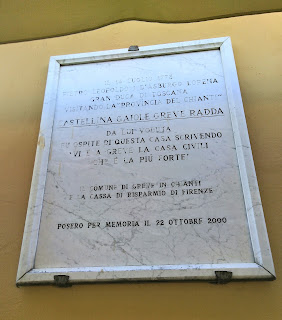Piazza Matteotti, Greve in Chianti
Greve in Chianti is arguably the liveliest, most interesting and possibly most hospitable town in Chianti, but its square is indubitably the most attractive sight in Greve. Roughly triangular in shape, it is also distinctive for its porticoes around all three sides and the chain of terraces above, from where residents, restaurants and bed and breakfast places enjoy the view.

Piazza Matteotti, called Piazza Re Umberto in the 19th century, has for 500 years been the site of a market which served both farmers and landowners from the
surrounding countryside and which gradually grew into a market town.



Equally importantly, the square has always been the community's focal point: its meeting place, its social hub, the place for celebration and at times grieving. The church at the south end, the town hall to the north with all the local businesses and activities in between, the square is Greve's living room.

The church of Santa Croce at the south end of the square was founded as a chapel in the 11th century, rebuilt in 1325 after being burnt to the ground by Castruccio Castracani of Lucca during his wars against Florence, and rebuilt again in 1833 in a neo-classical-neorenaissance style.
The statue of Giovanni da Verrazzano the explorer (1485–1528), attests to his family estate in the neighbourhood; whether he was born in Greve is up for scholarly debate. On the other hand, the family of Amerigo Vespucci (1454-1512) resided in the nearby castle of Montefioralle. Two famous navigators and explorers whose families had estates in the heart of the Tuscan countryside.
Another notable Grevigiano, commemorated by a plaque in the square, was a friend of Galileo Galilei: Giovannibattista Ciampoli (1590-1643), who witnessed the former's observations with the telescope and tried to be his ally in Galileo's conflicts with the Church.
Svuota la Soffitta: Empty the Attic, various times through the year when locals sell off and recycle their belongings;
il Pagliaio: Organic Market, every fourth Sunday from February to November;
Vetrina Citta Slow: a food and crafts fair highlighting products of Italy's SlowFood movement, in May;
Stelle e Mercanti: evening market with crafts and foods, various times through the summer;
Festa del Vino: Wine Festival (first week of September);
Aspettando Natale: Christmas Market in early December
In addition, the 'Borgo' or via Roma, which leads north from the square, each July hosts a dinner called La Tavola Longa or Long Table which literally runs down the centre of the entire length of the street. 15 euros for four courses and drinks.

 |
| Piazza Matteotti, looking south |

 |
| the beautiful porticoes of Greve: shade in summer and shelter in winter |
Piazza Matteotti, called Piazza Re Umberto in the 19th century, has for 500 years been the site of a market which served both farmers and landowners from the
surrounding countryside and which gradually grew into a market town.



Equally importantly, the square has always been the community's focal point: its meeting place, its social hub, the place for celebration and at times grieving. The church at the south end, the town hall to the north with all the local businesses and activities in between, the square is Greve's living room.
 |
| Greve's most famous shop, Falorni, an historical butcher and salumeria which now also offers light meals at a reasonable price to be eaten in or outside in the company of a wild boar |

The church of Santa Croce at the south end of the square was founded as a chapel in the 11th century, rebuilt in 1325 after being burnt to the ground by Castruccio Castracani of Lucca during his wars against Florence, and rebuilt again in 1833 in a neo-classical-neorenaissance style.
The statue of Giovanni da Verrazzano the explorer (1485–1528), attests to his family estate in the neighbourhood; whether he was born in Greve is up for scholarly debate. On the other hand, the family of Amerigo Vespucci (1454-1512) resided in the nearby castle of Montefioralle. Two famous navigators and explorers whose families had estates in the heart of the Tuscan countryside.
Another notable Grevigiano, commemorated by a plaque in the square, was a friend of Galileo Galilei: Giovannibattista Ciampoli (1590-1643), who witnessed the former's observations with the telescope and tried to be his ally in Galileo's conflicts with the Church.
 |
| This plaque instead commemorates the liberation of Greve in Chianti by British troops in July 1944 |
 |
| the annual wine festival in early September has been a feature of Greve's life since the 1950s |
Greve hosts a series of festivals and fairs throughout the year. The town's 'living-room' is where all events take place, spilling out into the surrounding streets and spaces. A list of the most significant:
Fiera delle Cose del Passato: Antiques Fair, Easter Monday;
Festa dei Fiori: Flower Festival early May; Svuota la Soffitta: Empty the Attic, various times through the year when locals sell off and recycle their belongings;
il Pagliaio: Organic Market, every fourth Sunday from February to November;
Vetrina Citta Slow: a food and crafts fair highlighting products of Italy's SlowFood movement, in May;
Stelle e Mercanti: evening market with crafts and foods, various times through the summer;
Festa del Vino: Wine Festival (first week of September);
Aspettando Natale: Christmas Market in early December
In addition, the 'Borgo' or via Roma, which leads north from the square, each July hosts a dinner called La Tavola Longa or Long Table which literally runs down the centre of the entire length of the street. 15 euros for four courses and drinks.








No comments:
Post a Comment
Comments are welcome but will be checked before publishing.